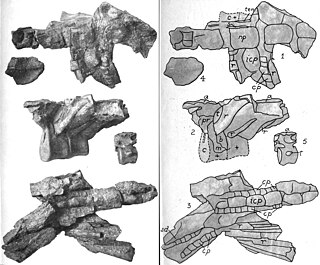
Nodosaurus is a genus of herbivorous nodosaurid ankylosaurian dinosaur from the Late Cretaceous, the fossils of which are found exclusively in the Frontier Formation in Wyoming.

Animantarx is a genus of nodosaurid ankylosaurian dinosaur from the Early and Late Cretaceous of western North America. Like other nodosaurs, it would have been a slow-moving quadrupedal herbivore covered in heavy armor scutes, but without a tail club. The skull measures approximately 25 cm in length, suggesting the animal as a whole was no more than 3 meters long.

Labocania is a genus of carnivorous theropod dinosaur of disputed affinities from the Late Cretaceous of Mexico. Initially regarded as an indeterminate theropod, later studies mentioned possible affinities with tyrannosaurids, abelisaurids, or carcharodontosaurids. More recent research based on additional fossil material found support for a position within the tyrannosaurine clade Teratophoneini. Two species have been proposed: L. anomala, likely from the La Bocana Roja Formation, and L. aguillonae from the Cerro del Pueblo Formation.

Gastonia is a genus of herbivorous ankylosaurian dinosaur from the Early Cretaceous of North America, around 139 to 134.6 million years ago. It is often considered a nodosaurid closely related to Polacanthus. Gastonia has a sacral shield and large shoulder spikes.

Struthiosaurus is a genus of nodosaurid dinosaurs, from the Late Cretaceous period (Santonian-Maastrichtian) of Austria, Romania, France and Hungary in Europe. It was a small dinosaur, measuring 2–3 m (6.6–9.8 ft) in length and weighing 300–400 kg (660–880 lb).

Aletopelta is a monospecific genus of basal ankylosaurid dinosaur from Southern California that lived during the Late Cretaceous in what is now the Point Loma Formation. The type and only species, Aletopelta coombsi, is known from a partial skeleton preserving osteoderms. It was originally described in 1996 by W. P. Coombs, Jr. and T.A. Deméré before being named in 2001 by Tracy Ford and James Kirkland. Aletopelta has an estimated size of 5 metres and weight of 2 tonnes. The holotype formed a miniature reef and was scavenged upon by invertebrates and sharks.

Sauropelta is a genus of nodosaurid dinosaur that existed in the Early Cretaceous Period of North America. One species has been named. Anatomically, Sauropelta is one of the most well-understood nodosaurids, with fossilized remains recovered in the U.S. states of Wyoming, Montana, and possibly Utah. It is also the earliest known genus of nodosaurinae; most of its remains are found in a section of the Cloverly Formation dated to 108.5 million years ago.
Sauroplites is a genus of herbivorous ankylosaurian dinosaur from the Early Cretaceous of China.
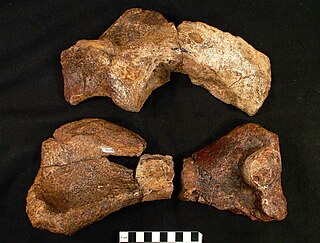
Texasetes is a genus of ankylosaurian dinosaurs from the late Lower Cretaceous of North America. This poorly known genus has been recovered from the Paw Paw Formation near Haslet, Tarrant County, Texas, which has also produced the nodosaurid ankylosaur Pawpawsaurus.
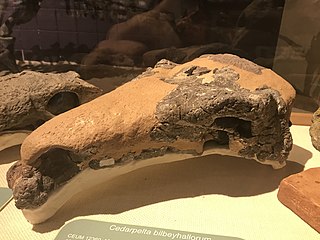
Cedarpelta is an extinct genus of basal ankylosaurid dinosaur from Utah that lived during the Late Cretaceous period in what is now the Mussentuchit Member of the Cedar Mountain Formation. The type and only species, Cedarpelta bilbeyhallorum, is known from multiple specimens including partial skulls and postcranial material. It was named in 2001 by Kenneth Carpenter, James Kirkland, Don Burge, and John Bird. Cedarpelta has an estimated length of 7 metres and weight of 5 tonnes (11,023 lbs). The skull of Cedarpelta lacks extensive cranial ornamentation and is one of the only known ankylosaurs with individual skull bones that are not completely fused together.

Mymoorapelta is a nodosaurid ankylosaur from the Late Jurassic Morrison Formation of western Colorado and central Utah, USA. The animal is known from a single species, Mymoorapelta maysi, and few specimens are known. The most complete specimen is the holotype individual from the Mygatt-Moore Quarry, which includes osteoderms, a partial skull, vertebrae, and other bones. It was initially described by James Kirkland and Kenneth Carpenter in 1994. Along with Gargoyleosaurus, it is one of the earliest known nodosaurids.

Muzquizopteryx is a genus of nyctosaurid pterodactyloid pterosaur from the Late Cretaceous period of what is now Coahuila, Mexico.

Ahshislepelta is a monospecific genus of ankylosaur dinosaur from New Mexico that lived during the Late Cretaceous in what is now the Hunter Wash Member of the Kirtland Formation. The type and only species, Ahshislepelta minor, is known only from an incomplete postcranial skeleton of a small subadult or adult individual. It was named in 2011 by Michael Burns and Robert M. Sullivan. Based on the size of the humerus, Ahshislepelta is larger than Pinacosaurus mephistocephalus but smaller than Talarurus and Pinacosaurus grangeri.

Latirhinus is an extinct genus of lambeosaurine hadrosaurid dinosaur from the Late Cretaceous of Mexico. The type species, Latirhinus uitstlani, was named in 2012 on the basis of a partial skeleton from the Campanian-age Cerro del Pueblo Formation. The specific name uitstlani means "southern" in the Náhuatl language of Mexico, a reference to the species' southern occurrence in the Cretaceous landmass Laramidia.
Dongyangopelta is an monospecific genus of nodosaurid dinosaur that lived in China during the Early to Late Cretaceous period in what is now the Chaochuan Formation. The type and only known species, Dongyangopelta yangyanensis, is known from a partial postcranial skeleton preserving osteoderms and ossified tendons. It was named in 2013 by Rongjun Chen, Wenjie Zheng, Yoichi Azuma, Masateru Shibata, Tianling Lou, Qiang Jin and Xinsheng Jin. Dongyangopelta represents one of the only nodosaurids known from Asia, along with Taohelong and Sauroplites.
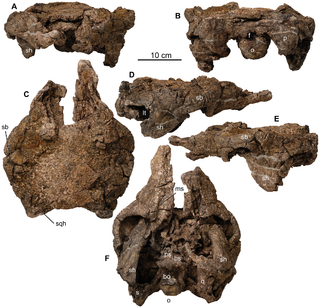
Europelta is a monospecific genus of nodosaurid dinosaur from Spain that lived during the Early Cretaceous in what is now the lower Escucha Formation of the Teruel Province. The type and only species, Europelta carbonensis, is known from two associated partial skeletons, and represents the most complete ankylosaur known from Europe. Europelta was named in 2013 by James I. Kirkland and colleagues. Europelta has an estimated length of 5 metres and weight of 1.3 tonnes, making it the largest member of the clade Struthiosaurini.
The Pen Formation is a Campanian-age geologic unit in the western United States.

Yehuecauhceratops [jɛhwɛkaoʔkɛratops] is a genus of horned centrosaurine ceratopsid dinosaur from the Late Cretaceous of Coahuila, Mexico. It contains a single species, Y. mudei, described from two partial specimens by Rivera-Sylva et al. in 2016 and formally named by Rivera-Sylva et al. in 2017. It was a small centrosaurine with a body length of 3 metres (9.8 ft), making it smaller than Agujaceratops and Coahuilaceratops, the other two ceratopsids in its environment; the three may have been ecologically segregated. A ridge bearing a single roughened projection near the bottom of the squamosal bone, which probably supported a small horn, allows Yehuecauhceratops to be distinguished from other centrosaurines. Its affinities to nasutoceratopsin centrosaurines, such as Avaceratops and Nasutoceratops, are supported by various morphological similarities to the former.
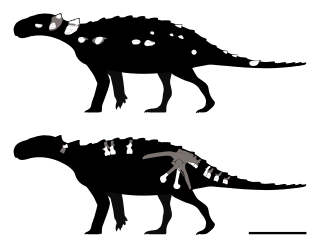
Patagopelta is an extinct genus of ankylosaurian dinosaur from the Late Cretaceous Allen Formation of Argentina. The genus contains a single species, P. cristata, known from a partial skeleton. While originally described as a nodosaurine, later discoveries provided support for parankylosaurian affinities for the taxon. Patagopelta is a very small ankylosaur, comparable in size to the dwarf nodosaurid Struthiosaurus, about 2 m (6.6 ft) long.

Coahuilasaurus is an extinct genus of kritosaurin ornithopod dinosaur from the Late Cretaceous (Campanian) Cerro del Pueblo Formation of Coahuila, Mexico. The genus contains a single species, C. lipani, known from the associated tips of the upper and lower jaw and other fragmentary skull bones. It is a large kritosaurin with an estimated body length of 8 metres (26 ft).


















